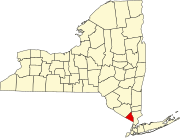
Harriman is a village in Orange County, New York, United States. It is in the southeastern section of the town of Monroe, with a small portion in the town of Woodbury. The population was 2,424 at the 2010 census. It is part of the Poughkeepsie–Newburgh–Middletown, NY Metropolitan Statistical Area as well as the larger New York–Newark–Bridgeport, NY-NJ-CT-PA Combined Statistical Area.

Sloatsburg is a village in the town of Ramapo in Rockland County, New York, United States. Located east of Orange County, it is at the southern entrance to Harriman State Park. The population was 3,039 at the 2010 census. The village is named after Stephen Sloat, an early European landowner.
The Erie Railroad was a railroad that operated in the northeastern United States, originally connecting New York City — more specifically Jersey City, New Jersey, where Erie's Pavonia Terminal, long demolished, used to stand — with Lake Erie. It expanded west to Chicago with its 1865 merger with the former Atlantic and Great Western Railroad, also known as the New York, Pennsylvania and Ohio Railroad. Its mainline route proved influential in the development and economic growth of the Southern Tier of New York State, including cities such as Binghamton, Elmira, and Hornell. The Erie Railroad repair shops were located in Hornell and was Hornell's largest employer. Hornell was also where Erie's mainline split into two routes, one north to Buffalo and the other west to Chicago.

The Montour Railroad was a short line railroad company operating passenger and freight service in southwestern Pennsylvania. At its height in the 1930s, the railroad served 27 mines transporting nearly seven million tons of coal annually in Allegheny and Washington Counties.
Sterling Forest, New York is a hamlet in the Town of Warwick, Orange County. It is served by an active United States post office of the same name. It is situated on the eastern shore of Greenwood Lake, at the New Jersey state line. Part of the hamlet extends into West Milford Township, Passaic County, New Jersey. The hamlet grew up around the terminal station of the Montclair and Greenwood Lake Railway, later called the New York and Greenwood Lake Railway, and later the Greenwood Lake division of the Erie Railroad. The railroad reached this point around 1875, with the station located at the state line in New Jersey. The depot complex originally contained the Sterling Forest, New Jersey post office. The post office was moved to the New York side of the line in 1926, where it continues to operate. Rail service ceased in 1935.
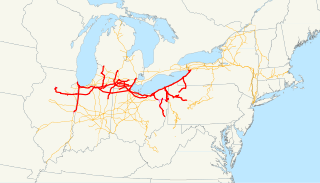
The Lake Shore and Michigan Southern Railway, established in 1833 and sometimes referred to as the Lake Shore, was a major part of the New York Central Railroad's Water Level Route from Buffalo, New York, to Chicago, Illinois, primarily along the south shore of Lake Erie and across northern Indiana. The line's trackage is still used as a major rail transportation corridor and hosts Amtrak passenger trains, with the ownership in 1998 split at Cleveland between CSX to the east, and Norfolk Southern in the west.
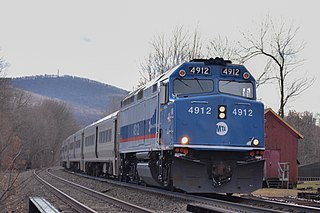
The Port Jervis Line is a predominantly single-track commuter rail line running between Suffern and Port Jervis, in the U.S. state of New York. At Suffern, the line continues south into New Jersey as NJ Transit's Main Line. The line is operated by NJ Transit Rail Operations under a working agreement with Metro-North Railroad (MNRR).
B&H Rail Corporation, formerly the Bath & Hammondsport Railroad, is a Class III shortline railroad. Initially the line served the communities of Bath, New York and Hammondsport, New York. In Bath, the railroad connected with the Erie Railroad and the Delaware, Lackawanna and Western Railroad. In 1996, the railroad was leased by the Livonia, Avon and Lakeville Railroad.

Little Falls is the second of two stations maintained by NJ Transit in Little Falls, New Jersey. The station, on the Montclair-Boonton Line is the first to receive limited revenue service due to the end of electrification at the site of the former Great Notch station. Little Falls station, located at Union Avenue in downtown has one side platform with the 1915 station depot, built of brick on the side. The station contains one track for revenue service, and a passing siding for trains. The station is the eighth fare zone, costing $8 for a one-way ticket to Hoboken Terminal and $1.25 more to transfer at Newark Broad Street to New York Pennsylvania Station. The station has 194 parking spaces, 134 on Railroad Avenue at Montclair Avenue and 60 more along Montclair Avenue. A ticket machine is available. The station is not accessible for handicapped persons. Anyone wishing to receive train service for handicapped must go to Montclair State University station or Wayne Route 23 Transit Center across the Passaic River in Wayne.

Mountain View, signed on the platform as Mountain View–Wayne, is a station on the Montclair-Boonton Line of NJ Transit in Wayne, New Jersey. Prior to the Montclair Connection in 2002, the station was served by the Boonton Line. The station is located on Erie Avenue, just off of US 202 and Route 23 in Downtown Wayne. Since January 2008, Mountain View station is the second of two stations in Wayne, the other being the Wayne Route 23 Transit Center, a station off the Westbelt interchange.
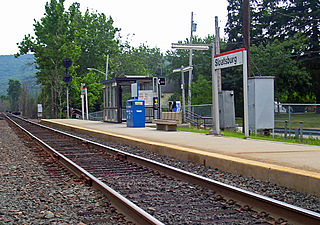
Sloatsburg station is a commuter rail stop on the Metro-North Railroad's Port Jervis Line, located in the village of Sloatsburg, New York at the intersection of Municipal Plaza and Mills Street.
Seven Lakes Drive is a north–south parkway located in the Hudson Valley region of New York in the United States. It extends for just under 18 miles (29 km) on a northeast–southwest alignment from an intersection with New York State Route 17 (NY 17) in the village of Sloatsburg to a junction with U.S. Route 9W (US 9W) and US 202 south of the Bear Mountain Bridge in the town of Stony Point. Most of the highway is located in either Harriman or Bear Mountain state parks, except for a small stretch near its western end. Ownership of Seven Lakes Drive is split between three entities, two of which are also responsible for maintenance of the road.

The New York and Greenwood Lake Railway owned a line between Croxton, Jersey City, New Jersey and Greenwood Lake, New York. Service on the line was provided by the Erie Railroad.

Pompton Plains is a former railroad station in Pequannock Township, Morris County, New Jersey. United States. Located at 33 Evans Place in the Pompton Plains section of Pequannock, the station is a former stop on the Erie Railroad's Greenwood Lake Division. The station was a single side-platform station with service from Wanaque–Midvale station in Wanaque to Pavonia Terminal in Jersey City, where connections were made to ferries to New York City. The next station north was Pompton–Riverdale after 1951. The next station south was Pequannock.
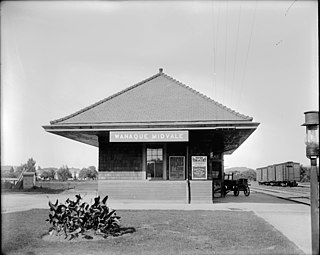
Wanaque–Midvale was a former commuter railroad station of the Erie Railroad's New York and Greenwood Lake Railway branch in Wanaque, New Jersey, United States. When built in 1873, the station served trains running from Pavonia Terminal in Jersey City to Sterling Forest on the New York–New Jersey border alongside Greenwood Lake and trains going to Ringwood on the Ringwood Branch. At the time there were two stations, one at Wanaque and one at Midvale. The next station northbound towards Sterling Forest was Boardville; heading towards Ringwood it was Erskine. The next station south was Haskell.

Corning was a major station along the Erie Railroad, located on the Susquehanna Division of the main line. Located originally in downtown Corning, New York, the station first opened on the line in January 1850, with the completion of the New York and Erie Railroad from Piermont in Rockland County to Dunkirk in Chautauqua County. The first depot at Corning was built in 1861 and located at the intersection of Erie Avenue and Pine Street in Corning. The station lasted at this location until 1952, when construction of a new track bypass of Corning began. The newer depot opened on November 21, 1952. This new station was located at the junction of West Sycamore Street and North Bridge Street on the north side of Corning.
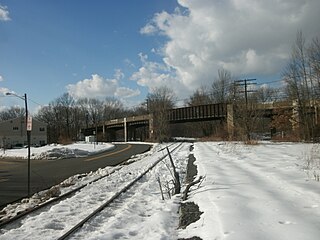
Mountain View was a station on the Boonton Branch of the Delaware, Lackawanna and Western Railroad. Located in the Mountain View section of Wayne Township, New Jersey, the station was at the Parish Drive bridge over the tracks. The station was 20.8 miles (33.5 km) away from its terminus at Hoboken Terminal on the shores of the Hudson River, where connections would be made to New York City via ferry and the Hudson and Manhattan Railroad. The western terminus. Denville, was 12.8 miles (20.6 km) away, where connections with the Morris and Essex Railroad were available. Just west of the station was Mountain View junction, where a connection was made to the Erie Railroad's New York and Greenwood Lake Railway was made.

Pompton–Riverdale is a former railroad station in the borough of Riverdale. Morris County, New Jersey, United States. Located at 13 Pompton–Hamburg Turnpike, the station was a stop on the Greenwood Lake Division of the Erie Railroad. A single side platform station with two tracks, the current station was built in 1919. The next station to the north was Pompton Junction, where connections were available to the New York, Susquehanna and Western Railroad, another Erie Railroad subsidiary. The next station south was Pompton Plains.

Pompton Junction is a former railroad station and active railroad junction in the borough of Pompton Lakes, New Jersey, United States. The station is located on the New York and Greenwood Lake Railway and the New York, Susquehanna and Western Railway, both subsidiaries of the Erie Railroad. Pompton Junction contained two side platforms at a diamond crossing, with a station depot on the Susquehanna Railroad side and a station canopy on the Greenwood Lake side. A railroad tower with the telegraph call letters "PJ" was present on the Greenwood Lake side of the station.
The 1958 Sterlington Railroad Disaster was a head-on collision by two Erie Railroad trains on August 11, 1958 at 6:47 AM killing 5 people and injuring 22 to 36. The collision occurred when the operator in the signal tower at Suffern failed to hold the westbound train No. 53 at Suffern for the eastbound No. 50 commuter train from Monroe, New York, to Hoboken, New Jersey. When he realized his error, he attempted to contact the crews via radio but was unsuccessful due to a radio dead spot. The trains impacted head-on right in front of the abandoned Erie Railroad Sterlington railroad depot in Sterlington, New York near Sloatsburg, killing the crew of the locomotive No. 859 from train No.50 as well as two passengers and injuring the crew of the locomotive No. 1402 from the westbound train.
















